Garden Invaders? Identifying and Managing Outdoor Termite Colonies in California

California’s sunny climate and lush landscaping may seem like the perfect paradise for homeowners. However, that same climate also creates ideal conditions for one of nature’s most destructive pests: termites. While many property owners are familiar with the danger of indoor termite infestations, fewer are aware of the threat posed by outdoor termite colonies. These silent invaders can exist unnoticed in gardens, yards, and the soil surrounding homes—until the damage is done. In California, managing and preventing termite activity around your property requires vigilance, informed identification, and proactive action. Let’s delve into the nature of these outdoor colonies, how to recognize them, and the best practices for outdoor termite prevention around California foundations.
The Hidden World of Outdoor Termite Colonies
Outdoor termite colonies are often more elusive than their indoor counterparts. Typically nesting underground, these colonies can thrive for years without direct contact with a structure, slowly working their way toward foundations, fences, decks, and tree roots. The most common culprits in California are subterranean termites (especially the destructive Western subterranean termite) and, in warmer southern regions, drywood termites. Unlike drywood termites, which live directly inside wood, subterranean termites build massive colonies in the soil and rely on moisture to survive.
These colonies are often established near woodpiles, mulch beds, rotting tree stumps, or areas with excessive moisture such as overwatered lawns or poorly drained garden beds. Once mature, the colony sends out exploratory foraging tubes—mud tubes—that can stretch several feet above ground or into the foundations of nearby buildings. The termites work 24/7, digesting cellulose-based materials (wood, paper, plant debris) and causing structural deterioration without immediate signs.
In California’s diverse microclimates, termite activity can persist year-round but spikes in spring and summer due to increased humidity and warmth, which trigger swarming events. Swarms are mating flights of winged termites (alates) searching for new nesting grounds—a clear warning that a colony is nearby.
Signs of Outdoor Termite Activity You Shouldn’t Ignore
Spotting termites outdoors before they reach your home is your best defense. Unfortunately, their stealthy behavior means they often go unnoticed until significant damage has occurred. However, with a careful eye, there are several key indicators to watch for.
One of the most telltale signs is the presence of mud tubes—small, pencil-sized tunnels made of soil and saliva—on the sides of foundations, retaining walls, planters, or even up trees and fences. These tubes protect termites from light and predators as they travel between their nest and food sources. Discovering these tubes, even if not actively swarming, suggests an active colony nearby.
Another sign is damaged wood. Wood that sounds hollow when tapped or crumbles easily may be infested. Peeling back soil from wooden structures like landscape timbers or raised garden beds might reveal termite galleries, characterized by smooth, maze-like patterns.
You might also find discarded wings around garden lights, window sills, or patio areas. Termite alates shed their wings shortly after landing and attempting to establish a new colony. If you observe such swarms or wing piles in your yard, there’s a high probability of nearby termite activity.
Lastly, localized areas of dead or dying plants, particularly if the roots or stalks seem chewed or structurally weakened, can also be a subtle hint. While not all dying plants indicate termite presence, subterranean termites have been known to tunnel into moist root systems for food.
The California Factor: Why Termite Risk Is Elevated in the Golden State
California’s unique environmental conditions make it a hotspot for termite activity. The combination of warm temperatures, varied coastal and inland moisture levels, and an abundance of organic landscaping materials creates the perfect storm for termite survival and proliferation.
Subterranean termites are especially prevalent in Northern and Central California, where soil moisture levels provide ideal conditions for underground nesting. Drywood termites, on the other hand, are more dominant in Southern California, where they infiltrate exposed wooden structures and live directly within them, eliminating the need for soil contact.
In areas where wildfires and drought are common, termite risk doesn’t disappear—it shifts. Post-fire landscaping and construction often introduce untreated wood and increase water use for plant reestablishment. These changes can inadvertently create a termite-friendly environment. Similarly, droughts cause termites to seek moisture sources near irrigation systems, leaky hoses, and shaded garden areas, pushing colonies closer to home foundations.
The key issue is that California homeowners often focus their termite prevention strategies indoors, not realizing that the battle must begin outside. Understanding the environmental factors in your specific region—humidity, soil type, plant density, and seasonal rainfall—can better equip you to safeguard your property.
Managing Outdoor Colonies: From Detection to Treatment
Early detection is critical when dealing with outdoor termite colonies. Homeowners can perform simple visual inspections around their property, especially in spring and fall. Pay close attention to fence posts, deck footings, planter boxes, and the junction where soil meets foundation walls. Lift stones, firewood, and potted plants to check for hidden termite tunnels.
Once a colony is suspected or confirmed, professional pest control intervention is often necessary. Termite specialists can conduct thorough inspections using tools like moisture meters, infrared cameras, and acoustic emission devices to locate colonies underground or within wooden structures.
Treatment strategies vary based on the termite species and colony size. For subterranean termites, liquid termiticides are commonly applied to create a chemical barrier in the soil around the home’s perimeter. In some cases, baiting systems—plastic stations inserted into the ground—lure termites and gradually kill the colony using slow-acting toxins.
Drywood termites, which nest above ground, may require localized wood treatments or full-structure fumigation depending on the extent of the infestation. However, outdoor wooden furniture or pergolas can often be treated with borate-based solutions, which penetrate the wood and offer long-term protection.
Homeowners should also address environmental factors to make their yard less appealing to termites. This includes improving drainage, reducing wood-to-soil contact, sealing foundation cracks, removing dead tree stumps, and spacing plants to allow airflow. Even switching to termite-resistant mulch materials—such as rubber mulch or gravel—can help.
Best Practices for Outdoor Termite Prevention Around California Foundations
Preventing termite invasions requires a combination of monitoring, habitat modification, and protective barriers. The most effective approach is holistic—treat the garden, perimeter, and structure as interconnected components.
Begin with landscaping: Avoid piling mulch or soil directly against the foundation. Instead, maintain at least six inches of visible clearance between the soil and any exposed wood siding. Keep vegetation trimmed back from the house to allow for airflow and inspection access. Consider planting termite-resistant species and avoid wood-based landscaping materials unless treated or naturally resistant, such as cedar or redwood.
Irrigation is another critical area. Overwatering attracts termites by increasing soil moisture, so use drip irrigation systems with timers and inspect for leaks frequently. Ensure gutters and downspouts direct water away from the home’s base.
Inspect and maintain foundation integrity. Fill in cracks and crevices in concrete or brick with appropriate sealants. Termites can exploit even the smallest gaps to access structural wood. Additionally, any vents or crawlspace openings should be screened with fine mesh to keep alates from entering.
Homeowners should also schedule annual inspections by a licensed pest professional. These experts can spot early warning signs that may go unnoticed and recommend appropriate treatments or modifications.
If construction or landscaping is underway, always use pressure-treated wood or pre-construction soil treatments to create an initial defense. In high-risk zones, installing stainless steel mesh or sand barriers around foundations can provide long-term physical deterrents.
Lastly, awareness is your best tool. Understanding the lifecycle, behavior, and threats of termites specific to California empowers you to take timely action. Whether it’s identifying that strange mud tunnel along your patio edge or choosing the right materials for a backyard renovation, small steps can prevent enormous costs down the line.
Conclusion
Termites are garden invaders that thrive in silence. But with informed eyes, proactive measures, and professional support, California homeowners can outsmart these destructive pests and keep their outdoor spaces—and foundations—safe for years to come.
Need Pest Control Near You?
If you’re dealing with unwanted pests in your home, business, or industrial facility, don’t wait—reach out to us at Access Better Pest Management. Our expert team in Corona, CA is ready to deliver tailored solutions that go beyond just eliminating infestations—we ensure long-term protection and peace of mind. From thorough termite and rodent inspections to customized treatment plans and damage repairs, we’ve got you covered. Let us put our experience and dedication to work for you—contact us today and take the first step toward a safer, pest-free environment.
